Transition metal orbitals - Study guides, Class notes & Summaries
Looking for the best study guides, study notes and summaries about Transition metal orbitals? On this page you'll find 109 study documents about Transition metal orbitals.
All 109 results
Sort by
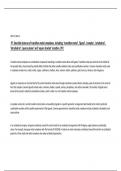 Popular
Popular
-
Unit 13C applied science- Inorganic Chemistry
- Essay • 28 pages • 2024
-
- $10.02
- 3x sold
- + learn more
Here is a bulleted summary of the key points from the document: • Introduction to transition metal complexes - Definition of transition metals, ligands, complexes - Common coordination geometries: octahedral, tetrahedral, square planar - Square bracket notation to describe geometries • Bonding in transition metal complexes - Coordinate covalent bonding between metal and ligands - Presence of back-bonding from metal to ligand π* orbitals - Combination of covalen...
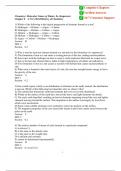
-
Test Bank for Chemistry: The Molecular Nature of Matter, 8th Edition by Jespersen
- Exam (elaborations) • 922 pages • 2024
-
- $29.49
- + learn more
Test Bank for Chemistry: The Molecular Nature of Matter, 8th Edition 8e by Neil D. Jespersen, Alison Hyslop. Full Chapters test bank are included with answers - Chapter 1 to 22 included 0 A Very Brief History of Chemistry 1 0.1 Chemistry’s Important Concepts 2 0.2 Supernovas and the Elements 3 0.3 Elements and the Earth 5 0.4 Dalton’s Atomic Theory 7 0.5 Internal Structure of the Atom 8 Tools for Problem Solving 20 Review Questions and Problems 21 1 Scientific Meas...
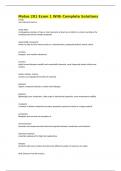
-
Matse 201 Exam 1 With Complete Solutions
- Exam (elaborations) • 11 pages • 2024
-
- $10.99
- + learn more
Matse 201 Exam 1 With Complete Solutions metals most elements exist as metal alloys a homogenous mixture of two or more elements at least one of which is a metal, and where the resulting material has metallic properties intermetallic compound similar to alloy but the mixture exists as a stoichiometric compound (distinct atomic ratios) ceramics inorganic, non-metallic substances ceramics solids formed between metallic and nonmetallic elements, most frequently oxides nitr...
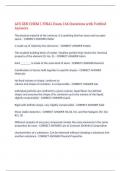
-
ACS GEN CHEM 1 FINAL Exam 166 Questions with Verified Answers,100% CORRECT
- Exam (elaborations) • 14 pages • 2024
-
- $11.99
- + learn more
ACS GEN CHEM 1 FINAL Exam 166 Questions with Verified Answers The physical material of the universe. It is anything that has mass and occupies space. - CORRECT ANSWER Matter is made up of relatively few elements. - CORRECT ANSWER Matter The smallest building block of matter. Smallest particle that retains the chemical property of the element (O, He, S). - CORRECT ANSWER Atom Each _______ is made of the same kind of atom - CORRECT ANSWER Element Combination of atoms held together i...
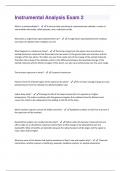
-
Instrumental Analysis Exam 2 Questions and Answers
- Exam (elaborations) • 13 pages • 2024
- Available in package deal
-
- $7.99
- + learn more
What is a photomultiplier? - A vacuum tube consisting of a photoemissive cathode, a series of intermediate electrodes called dynodes, and a collection anode. What does a single-beam spectrophotometer do? - A single-beam spectrophotometer employs one beam of radiation that irradiates one cell. What happens in a deuterium lamp? - The lamp energy from the power source produces an excited deuterium molecule that dissociates into two atoms in the ground state and a photon and the energies of th...
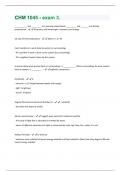
-
CHM 1045 - exam 3 Questions and Answers 100% Pass
- Exam (elaborations) • 11 pages • 2024
- Available in package deal
-
- $8.39
- + learn more
___________ and _________ are inversely proportional; _________ and _______ are directly proportional - frequency and wavelength ; frequency and energy 1st Law of Thermodynamics - delta-U = q + W heat transferred + work done by system on surroundings - W is positive if work is done on the system (by surrounding) - W is negative if work is done by the system A system doing work pushes back on surroundings, it ___________. When surroundings do work, pushes back on system, it _________ . - e...

-
Solutions Manual For Inorganic Chemistry, 6th Edition (Alen Hadzovic, 2024) Chapters 1-27, Latest Guide A+.
- Exam (elaborations) • 230 pages • 2024
-
- $24.99
- + learn more
Solutions Manual For Inorganic Chemistry, 6th Edition (Alen Hadzovic, 2024) Chapters 1-27, Latest Guide A+. TABLE OF CONTENTS Preface, v Acknowledgments, vii PART 1 Foundations Chapter 1 Atomic Structure Chapter 2 Molecular Structure and Bonding Chapter 3 The Structures of Simple Solids Chapter 4 Acids and Bases Chapter 5 Oxidation and Reduction Chapter 6 Molecular Symmetry Chapter 7 An Introduction to Coordination Compounds Chapter 8 Physical Techniques in Inorganic Chemistry PART ...
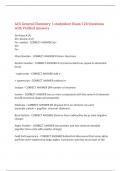
-
ACS General Chemistry 1 studysheet Exam 124 Questions with Verified Answers,100% CORRECT
- Exam (elaborations) • 10 pages • 2024
-
- $11.99
- + learn more
ACS General Chemistry 1 studysheet Exam 124 Questions with Verified Answers 56=Mass # (A) 26= Atomic # (Z) Fe= symbol - CORRECT ANSWER 56= 26= Fe= Mass Number - CORRECT ANSWER Proton+ Neutrons Atomic Number - CORRECT ANSWER # of protons/electrons (equal in elemental form) - superscript - CORRECT ANSWER Add e- + superscript - CORRECT ANSWER subtract e- Isotope - CORRECT ANSWER Diff number of neutrons Isomer - CORRECT ANSWER two or more compounds with the same # of elemen...
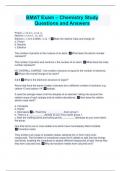
-
BMAT Exam – Chemistry Study Questions and Answers
- Exam (elaborations) • 8 pages • 2024
-
Available in package deal
-
- $9.99
- + learn more
Proton = r.m is 1, r.c is +1 Neutron = r.m s 1, r.c. is 0 Electron = r.m is 0.0005, r.c is -1 State the relative mass and charge of: a. Proton b. Neutron c. Electron The number of protons in the nucleus of an atom. What does the atomic number represent? The number of protons and neutrons n the nucleus of an atom. What does the mass number represent? NO OVERALL CHARGE - the number of protons is equal to the number of electrons. What s the overall charge of an atom? 2,8,8 What is ...

-
ACS Gen Chem 1 Exam Questions With Complete Solutions Graded A+
- Exam (elaborations) • 4 pages • 2023
- Available in package deal
-
- $7.99
- + learn more
Ion - A species of an element in which the number of electrons does not equal the number of protons. Isotope - Each isotope of an atom has a different number of neutrons. Isoelectric - Two atoms with the same charge. Isotopic - Two atoms with the same number of neutrons. Transition Metal Orbitals - The 4s orbital is filled before the 3d orbital, but listed after. Paramagnetic - Atoms that possess a permanent magnetic charge due to the presence of unpaired electrons. Electropositive - Ten...

Did you know that on average a seller on Stuvia earns $82 per month selling study resources? Hmm, hint, hint. Discover all about earning on Stuvia


